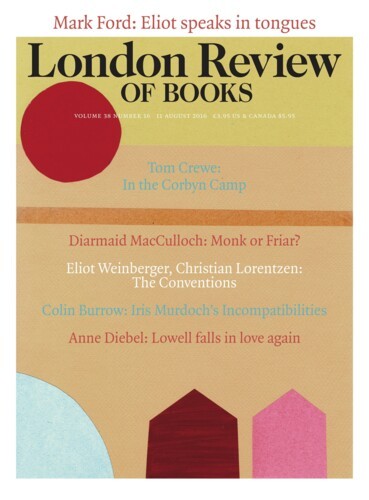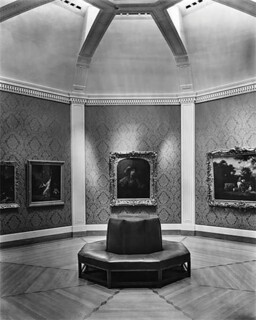The Fitzwilliam Museum in Cambridge is celebrating its 200th anniversary this year with a series of exhibitions and activities designed to illustrate different aspects of the collection, which since its foundation in 1816 has been wonderfully various: various enough at times in the past to constitute a muddle of badly hung or oddly displayed materials. Not that this stopped people liking it, as Humphrey Jennings made clear in 1929, when what he called ‘the hideous new wing’ was almost complete. Writing in the undergraduate magazine Experiment, he urged those who had never been there, as well as ‘old friends’, to visit the museum at once. ‘For it cannot be that the present glorious mix-up will remain; there will be a tidying-up and a sorting-out, a re-arranging and a re-hanging, and that muddle of sculpture, old clothes and superb water-colours … will have departed for ever.’ And of course there has been plenty of successful reorganisation and new building since then, as Lucilla Burn’s new history of the museum (Philip Wilson, £25) concisely and effectively demonstrates.
All through this year, an exhibition accompanies and fleshes out the new history, illuminating the character and achievements of successive directors, the often difficult relationship between the Fitzwilliam and the University of Cambridge, the challenges posed by both world wars (much of the collection was moved to Shropshire in 1939 and members of staff had to spend three weeks at a time there, acting as nightwatchmen) and the (quite interesting) personal life of the founder. Richard, seventh Viscount Fitzwilliam of Merrion was a collector on a fairly grand scale. When he died early in 1816, he owned about ten thousand printed books, 130 illuminated manuscripts, musical scores (most famously the Fitzwilliam Virginal Book), paintings by Veronese, Titian, Rembrandt and others, and more than forty thousand prints. All these he bequeathed to the university ‘for the purpose of promoting the Increase of Learning and the other great objects of that Noble Foundation’, along with a sum of money sufficient to build ‘a good substantial Museum Repository’. It was another 32 years before the grand neoclassical building in Trumpington Street was complete enough to house the collection, which was already growing as a result of bequests and donations. The subsequent history of the museum is very largely a history of donations and bequests, and of the museum directors who secured them.
The first gifts the museum received were, in 1822, the elaborate coffins made for an Egyptian man of some status named Nespawershefyt, who flourished in the period between 1070 and 890 bc, and a year later the lid of the sarcophagus of Rameses III. A combination of Napoleon’s depredations during his attempted conquest of Egypt and, in 1822, Champollion’s deciphering of hieroglyphs, led to a fashion for plundering the pristine tombs and antiquities of Egypt by amateur explorers and travellers, to the benefit of the Fitzwilliam, the Louvre and the British Museum among others.
Earlier this year, I went to the Fitzwilliam to see an exhibition of Egyptian coffins and funerary objects, some on loan from London and Paris but many from their own extensive collection. Death on the Nile, subtitled ‘Uncovering the Afterlife of Ancient Egypt’, was designed not just to showcase the collection but to illustrate the recent discoveries of a team of research scientists and conservators who had been working on the coffins for ten years, and, by setting them in chronological sequence, to outline the development of death rituals from 3000 bc to the period of Roman rule. Quite apart from the intrinsic beauty of the objects, large and small (especially small), the focus – thanks to MRI scans and chemical analysis – was on materials and on the work of the craftsmen who made the coffins or carved the models that some, like the tomb of Khety from about 2010-1950 bc, had contained: miniature boats and crews, brewers, butchers and bakers, a whole retinue for the afterlife.
As Burn makes clear in her lucid and detailed account of the Fitzwilliam’s development, a concern for craftsmanship has been central to its principles since probably the most influential period of its history, the directorship of Sydney Cockerell from 1908 to 1937. Cockerell, who followed M.R. James in the post, had been library cataloguer and acquisitions assistant to William Morris during the 1890s, and his taste was formed by Morris and Ruskin and their circles. He seems to have been relentlessly acquisitive, mostly on behalf of the Fitzwilliam, and the lists of the gifts he elicited constitutes a goodish proportion of the modern catalogue, especially when it comes to illuminated manuscripts, Old Master drawings, William Blake’s work, fine printed books and money for accessions and building. It was his predicted reorganisation that Jennings was objecting to, and which still dominated the museum walls in the 1950s.
The foundation of the museum in 1816 coincided with the ‘year of no summer’. The eruption of Mount Tambora in the Dutch East Indies brought predictions of the end of the world, widespread famine, crop disruption and civil unrest to Europe, dramatic sunsets to Britain and millennial thoughts to Byron, who ‘look’d up/With mad disquietude on the dull sky,/The pall of a past world … All earth was but one thought – and that was death.’ Nightmare visions of extinction and new forms of life, such as Byron’s and Mary Shelley’s, made a sharp but complementary contrast to the impulse to found museums to display the greatest products of civilisation and relate them to the nation’s, and the university’s, own civilising mission.
The Fitzwilliam has commemorated the year with a small exhibition of prints by Turner, Goya and Cornelius. The Turner prints are from Parts XI and XII of the Liber Studiorum and the curators do their best to link them to the extraordinary weather of 1816, claiming that ‘it is conceivable that the glowing sunset [in ‘Solitude’] was inspired by the fiery red skies of 1816, caused by the stratospheric volcanic dust cloud.’ The extreme weather didn’t do much damage in the Iberian peninsula, but following close on the insurrection and instability of 1808-14 the exhibition suggests it may have influenced the atmosphere of Goya’s Tauromaquia, especially coming, as it does, so soon after his earlier sequence, Los Desastres de la Guerra. Cornelius’s drawings for engravings on the subject of Goethe’s Faust were finished by 1811, so it’s harder to see them as direct responses to the climate and its consequences, but the finished suite makes a revealing comparison with the others.
The Fitzwilliam is very good at mounting small exhibitions of this sort, like the current Brueghel and His Time (until 4 September); anyone visiting one of the big exhibitions should look into the Octagon Room and the Charrington Print Room, too. And while Kettle’s Yard is being extended, there is a series of exhibitions entitled Being Modern (until 31 March), showing some of the works from that collection alongside pieces from the Fitzwilliam. M.R. James claimed there was insufficient work for two people in the Fitzwilliam Museum of the 1890s. There’s been a huge expansion since then, and major developments in all the areas of the museum in recent years, and it takes a great many more people to promote ‘the Increase of Learning’, but they do things better now.
Send Letters To:
The Editor
London Review of Books,
28 Little Russell Street
London, WC1A 2HN
letters@lrb.co.uk
Please include name, address, and a telephone number.


